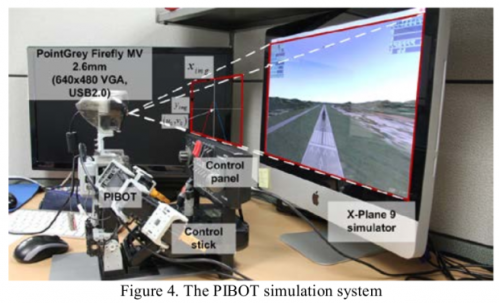September 21, 2014 weblog
Robot works controls of simulated cockpit: Introducing PIBOT

How close are we to a day when robots will fly airplanes? A presentation of a takeoff and landing simulation at the IROS (International Conference on Intelligent Robots and Systems) in Chicago this month, "A Robot-Machine Interface for Full-functionality Automation using a Humanoid," by Heejin Jeong, David Hyunchul Shim and Sungwook Cho, may help you to come up with answers. A small robot worked the controls of a simulated cockpit. PIBOT, as the robot was called, was able to work the controls, to the extent that it was able to identify and use the buttons and switches found in a real cockpit of a normal light aircraft designed for humans, reported Evan Ackerman in IEEE Spectrum. PIBOT as shown in the video prepares for flight by turning on the switches in the order of power, battery, altimeter etc. The engine starts and PIBO accelerates on the runway while following the center line of the runway. After climbing it takes turns, approaches the runway, aligns with the runway and makes a safe landing on the ground.
Kelsey Atherton in PopSci highlighted the significance of their work, in light of all the attention otherwise focused on drones. "Most drones are actually human-piloted, with the controls elsewhere and the pilot steering remotely. In this video, the pilot is itself a humanoid robot, learning how to fly an airplane in a flight simulator. With a panel of controls in its mechanical fingers, the PIBOT uses visual information, presented on a computer monitor, to inform its flying. Right now, the concept is limited to piloting simulators, but the researchers hope to have PIBOT actually steer a plane some day."
The team is from the Korea Advanced Institute of Science and Technology (KAIST) in South Korea. The Unmanned System Research Group (FDCL) at KAIST has its own home page where it describes its interest as in research and development of highly advanced autonomous aerial robots. They combine various principles of control theory, aerospace engineering, and computer science.
Ackerman, meanwhile, summarized the KAIST team's progress thus far. He wrote, "It can do takeoffs, follow waypoints, maneuver, and make a final approach to landing, although at this point, it still needs some human help for the final touchdown." He also said there are still some perception challenges to solve, "but they're getting very, very close."
More information: — spectrum.ieee.org/automaton/ro … o-fly-real-airplanes
© 2014 Tech Xplore




















